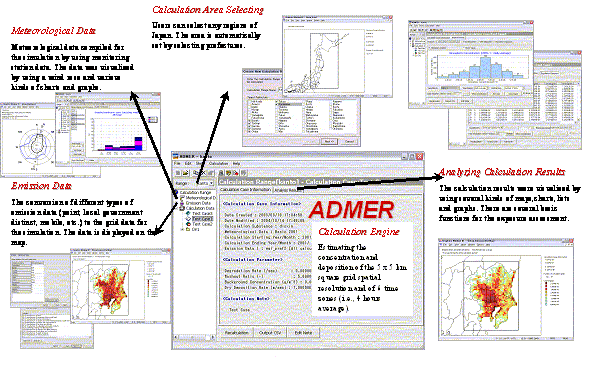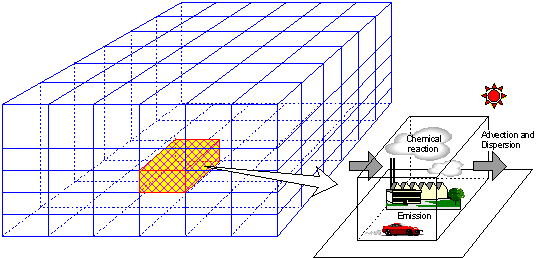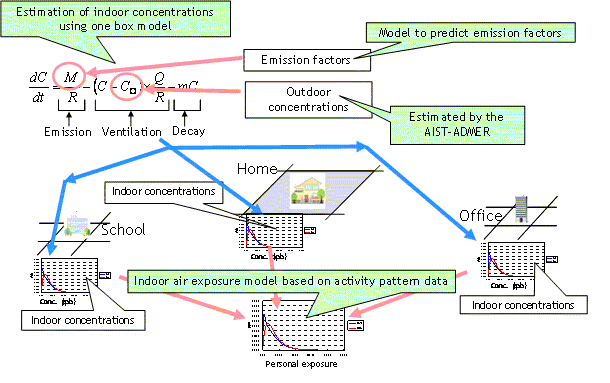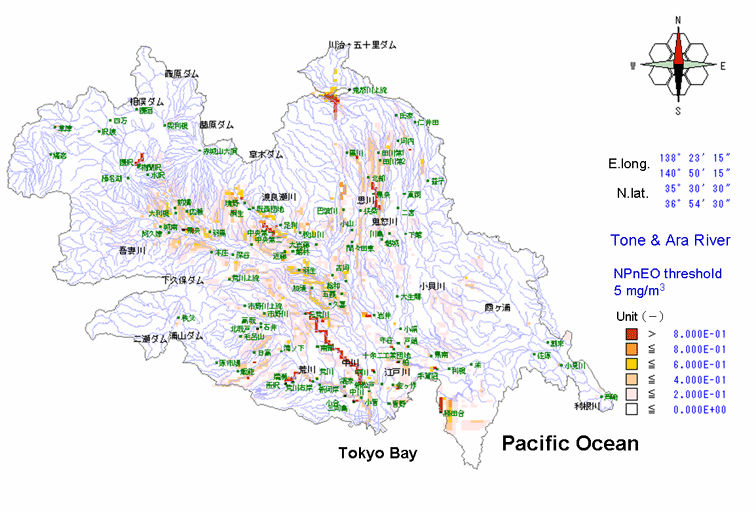Introduction to Environmental Exposure Modeling Team
Environmental Exposure Modeling Team (EMT) consists of 5 staff members (four researchers and one technical staff) with Dr. Haruyuki Higashino as the team leader. Major research subjects of the team are the development of various environmental exposure models for ambient atmosphere, indoor air, and rivers.
■ Regional-scale atmospheric model (ADMER) ■
The Atmospheric Dispersion Model for Exposure and Risk Management (ADMER) is the software designed to estimate the distribution of regional atmospheric concentrations of chemical substances and the exposure to populations.
In January 2007, we have developed the latest version (version 2) of ADMER. The new ADMER has a sub-grid module that will assist many users in their analysis of small areas such as cities, wards, towns, and villages. The sub-grid module increased the surface imagery considerably from every 5 km to the maximum of every 100 m.
The version 2.0 of ADMER with a Japanese user interface, which includes the sub-grid module, new GIS component, and any other improvements, is currently available. It is available to the general public and is downloaded and used free of cost.
Detailed download information on ADMER may be found at the following web site:
ADMER WEB site : http://www.riskcenter.jp/ADMER/
Version 1.5 with an English user interface has already been available. Future plans include the development of an international version which can perform simulations for all regions, both in and outside of Japan.

The capture of the user interface and major functions in the ADMER ver.1.5e
■ Next-generation regional-scale atmospheric model system■
Secondary air pollutants such as ozone and aldehydes are very important for the risk assessment of VOCs. The EMT is developing a next-generation regional-scale atmospheric model system for risk assessment of secondary air pollutants, to which the current version of ADMER cannot be applied.

Next-generation regional-scale atmospheric model system (Next-generation ADMER)
■ Indoor air exposure model ■
As for the human health risk of exposure to chemicals, the indoor exposure is also as important as the ambient air exposure. The EMT is developing an indoor exposure model which can estimate the exposure to both indoor and outdoor emissions, and is also developing the method to estimate the emission factors of various indoor consumer products.

Schematic diagram of
the indoor exposure model
■Model to estimate concentrations in river basins ■
It is necessary to obtain information on aquatic exposure concentration of chemicals for ecological risk assessment of aquatic organisms in river basins. However, it is often very difficult to evaluate the impacts to the ecological system using only observational data because of limited numbers of sampling sites and periods. For this reason, we have developed a software tool to estimate aquatic chemical exposure concentrations at higher temporal and spatial resolutions for chemical risk assessment and management in river basins, named ďAIST-Standardized Hydrology-based AssessmeNt tool for chemical Exposure Load (AIST- SHANEL)ĀE
This model also enables us to perform ecological risk assessment of chemicals by estimating the probability of exposure concentration exceeding a threshold for affecting the aquatic organisms. For example, in terms of ecological risk management, we can evaluate effectiveness of emission reduction measures and improvement of removal efficiency of sewage processing by calculating chemical concentrations with alternative parameters.
The AIST-SHANEL software has been released to the public and provided in the form of CD-ROM and download free of charge. For how to apply and get more information, you can access the URL
http://www.riskcenter.jp/SHANEL/

Probability of predicted concentrations of nonylphenol ethoxylate exceeding 5 mg/m3 in the Tone and Ara River basin.
Ā@